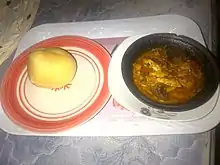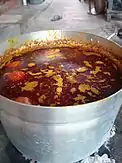Palm nut soup
Palm nut soup or banga is a soup made from palm fruit[1][2] common in the Ghanaian, Nigerian, Democratic Republic of Congo and Ivorian communities. The soup is made from a palm cream or palm nut base with stewed marinated meats, smoked dried fish, and aromatics. It is often eaten with starch, fufu, omotuo, banku, fonio, or rice. The use of the palm fruit in cooking is significant in Nigerian, Ghanaian and other West and Central African cuisine.

By region
Cameroon
Mbanga soup is a palm fruit soup in Cameroonian cuisine[3][4] and West African cuisine.[5] It is often served with kwacoco. The soup is Cameroon's version of the West African banga, a palm fruit soup eaten in areas including parts of Nigeria. In Cameroon mbanga is made using fresh palm nuts. Outside the area canned nuts can be used.[6]
Nigeria

_Rice..jpg.webp)
Banga is a type of palm fruit soup from Southern (the Niger Delta) Nigeria, particularly the Urhobo ethnic group.[7] This cuisine is quite different from ofe akwu, a variant found in Igbo culture. The Binis have a soup from palm fruits similar to ofe akwu" in ingredients and manner of preparation.[8][9]
In Nigeria, the delicacy is used to accompany other dishes such as Starch (Usi) for the Urhobo people of Delta State, Nigeria. The Igbo people have the stew and soup varieties made from palm fruits. Ofe akwu is the stew variety usually taken with rice while the palm fruit extract is used especially in Anambra region of Igbo land to prepare Oha and Onugbu soup accompanied with moulding foods (popularly known as 'swallow') e.g. pounded cassava (utara/akpu), corn/cassava flour (nni oka). The palm fruit is notably important to the Igbo people.
The palm fruit is often harvested from locally grown palm fruit trees, after which it is thoroughly washed, boiled and mashed for the extraction of its oil which is the main ingredient in the preparation of the Banga soup.
Banga soup is flavored with beletete, aidan fruit, rohojie, Banga spice leaves called Obenetietien (scent or bitter leaves can be substituted), a stick of oburunbebe, finely chopped onion, ground crayfish, chili pepper or scotch bonnet, and salt.[10] The soup is eaten with Starch made with Cassava Starch and palm-oil or rice in the south south or south eastern parts of Nigeria . Banga Soup is mostly prepared using fresh catfish (fresh fish Banga soup) dried/smoked fish or meat.
The soup can also make a delicious dish with the addition of Okra vegetable.[11]
Amiedi, also known as banga soup, is a soup eaten by the Urhobo people of Southern Nigeria. It is made by extracting the liquid of palm kernels. Thereafter, other ingredients like crayfish, meat, fish, pepper and cow tripe are added. It is eaten with eba or usi (starch). (Elaeis guineensis) extract.[12]
Gallery
 Palm nut soup with fish
Palm nut soup with fish Palm nut soup
Palm nut soup Akan Ghanaian palm nut soup
Akan Ghanaian palm nut soup Palm nut soup close up
Palm nut soup close up Palm nut soup
Palm nut soup Fufu with palm nut soup, snail and tilapia
Fufu with palm nut soup, snail and tilapia
See also
References
- Saffery, D. (2007). The Ghana Cookery Book. Jeppestown Press. p. 50. ISBN 978-0-9553936-6-2.
- Yussif, E. (2013). The Facet of Black Culture. Trafford Publishing. p. 53. ISBN 978-1-4669-8847-7.
- Osseo-Asare, Fran (November 24, 2005). Food Culture in Sub-Saharan Africa. Greenwood Publishing Group. ISBN 9780313324888 – via Google Books.
- Crush, Jonathan; Battersby, Jane (September 23, 2016). Rapid Urbanisation, Urban Food Deserts and Food Security in Africa. Springer. ISBN 9783319435671 – via Google Books.
- "Palmnut Soup". February 13, 2013.
- "Mbanga (Palm Nut) Soup". Jul 21, 2018. Retrieved Jul 11, 2021.
- "7 Amazing Health benefits of Banga soup | NccMed". nccmed.com. Retrieved 2023-08-23.
- "Banga Soup (Ofe Akwu)". All Nigerian Recipes. Retrieved 2020-06-04.
- "Ofe Akwu - Igbo Style Banga Soup". Sisi Jemimah. 2015-09-22. Retrieved 2020-06-04.
- How to make Banga Soup : Efik Banga Soup by Nky Lily Lete April 2013 Nigerian Food TV
- Saffery, David (2007). The Ghana Cookery Book. Jeppestown Press. pp. 50, 51. ISBN 9780955393662.
- Nutritional compositions and antioxidant properties of typical Urhobo Nigerian soups by Nyerhovwo J Tonukari, Oghenetega J Avwioroko, Guanah Seitonkumoh, Chinoye C Enuma, Samson O Sakpa, Linda Eraga, Theresa Ezedom, Ufuoma Edema, Enovwo Odiyoma, Akpovwehwee A Anigboro Vol 8, No 2 2013 Nigerian Journal of Technological Research